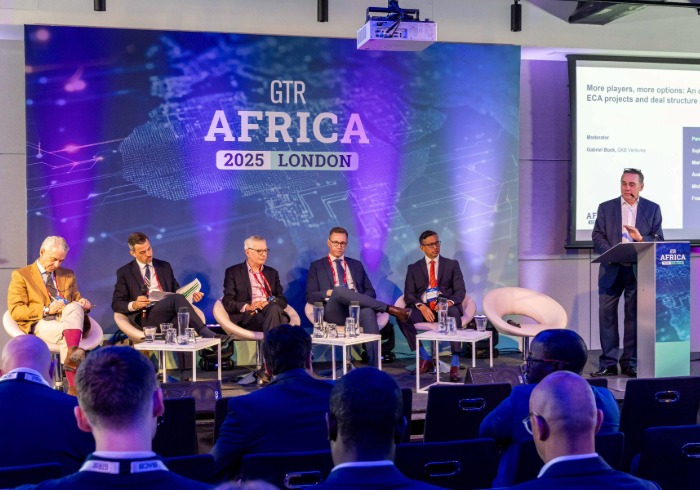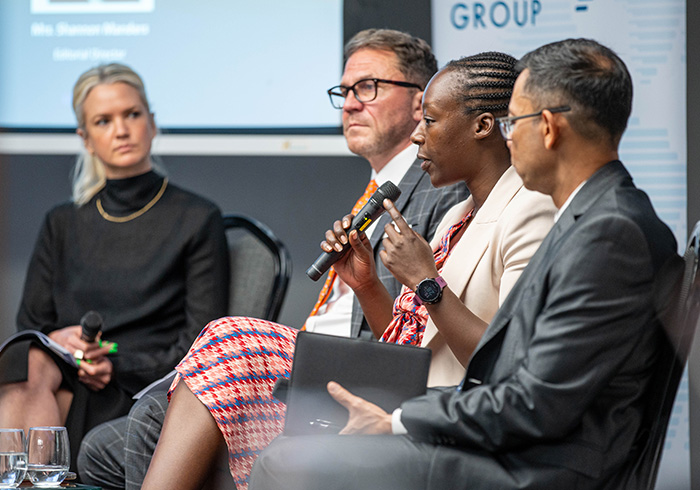Export credit agencies (ECAs) provide vital backing to developing economies in Africa, but is their offering comprehensive enough? Speaking at this year’s GTR Africa London event, industry insiders discussed the feasibility of expanding local currency facilities and longer tenor transactions to address the continent’s pressing need for infrastructure development.
Two years ago, ECA activity in Sub-Saharan Africa rebounded strongly after a pandemic-era lull, with new medium and long-term business rising from US$12bn in 2022 to US$23bn in 2023, according to Berne Union figures.
However, while volumes remained “relatively strong”, the equivalent figure for last year dipped to US$19.8bn, the Berne Union said. Just one market, Angola, accounted for a fifth of that total.
Demand for ECA support remains high, panellists said at the event held in London on November 20.
Standard Chartered’s Sujithav Sarangi said Africa faces immediate infrastructure needs, and by offering longer tenors and better pricing, ECAs “fill the gap” for governments facing high borrowing costs in the commercial market.
“We have seen that with Benin and other examples, where once they switched to ECA financing they were able to balance their books and come out in a much healthier shape,” said Sarangi, executive director for development and agency finance at the London-headquartered bank.
But as suggested by Mark Norris, a partner at law firm Sullivan, transactions “are taking longer to close” and there remains a challenge around affordability.
Gabriel Buck, managing director at export credit consultancy firm GKB Ventures, argued ECAs could consider bridging this gap by providing facilities in local currencies.
“Most countries’ debt sustainability problems are, in my opinion, about their hard currency debt, not their local currency debt,” he said. “I think that local currency financing is a better risk for a sovereign than hard currency.”
Norris said some projects “really do lend themselves to that local currency financing”, such as Zimbabwe’s Zimborders project, which is modernising infrastructure at the Beitbridge border post to cut delays and raise government revenue.
However, ECA representatives said current market dynamics make that difficult.
“Everyone would love to lend in local currency, which makes more sense for infrastructure projects,” said Anders Vium Gjelfort, associate director at Danish agency EIFO.
“The issue is… we don’t really have that capability to be strong in those currencies, so there will be a currency risk associated,” he said.
Francois Pennetier, regional head of origination and client coverage at UK Export Finance (UKEF), said local currency financing “makes a lot of sense for the borrowers, but sometimes it’s difficult to find the partners to provide that”.
“When you look at the ECA financing model, we mainly work with international banks… and do stuff in hard currency,” he said. “We need to find new partners, and it’s not easy, because they are not familiar with ECA financing.”
Standard Chartered’s Sarangi said he was “not sure whether there is depth in the local currency [market] to be able to finance these infrastructure projects”.
“Maybe there will be a movement towards this, as we see in India or Indonesia, where everything gets done in local currency,” he said. “But we are far from there now.”
Buck also suggested agencies could consider longer tenors for infrastructure projects expected to deliver benefits for several decades, but for which financing is typically provided for 15 to 20 years.
“In reality, we need that to go longer, to 30 or 40 years,” he said. “And we need that to be at a much lower cost. I think the onus is on us as financiers, ECAs, risk takers… to look at those types of solutions that don’t bankrupt the country and that fit with their own economic model.”
UKEF’s Pennetier agreed there is “a dichotomy between the life of the assets and the tenor of the funding, and that could certainly be improved”, but said there is a risk that extending maturity “push[es] the problem to tomorrow”.
EIFO’s Vium Gjelfort said: “On some of these items it makes sense, but there will be an incurred risk. Some issues would just be pushed down the road.”
Nevertheless, panellists warned that environmental and social requirements were slowing down deals on the continent.
“The time spent on the commercial covenants may actually be dwarfed by the time spent on the environmental and social covenants,” said Sullivan’s Norris.
Though those requirements were a “good thing”, Pennetier said there was “a lot of streamlining to do”.
“There’s a common understanding that in many cases, it’s becoming an impediment to investment,” he said. “I’m sure it’s the same for the banks. It doesn’t mean cutting corners, but it means being more effective at the way we do it.”








